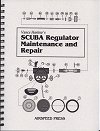Regulators - Servicing & Warranties
The "Regulator Tax" and the Buddy System
You should probably just skip this section
The scuba industry has successfully convinced the diving public that annual servicing of regulators is essential for your safety. Actually, at $50-$100 per regulator per year, annual servicing of regulators is far more essential to their bottom line than it is to your safety. Am I so cheap that I would risk my life to save less than $100? Not really.
All this is mixed up in business, economics, liability, and the fallacious buddy system. As you know, in the buddy system your buddy is theoretically your backup emergency air supply underwater, insuring not only against out-of-air situations, but also against equipment failures, and therefore you need only one tank and regulator. In keeping with this theory, you are sold a wholly inadequate breathing system with no built-in redundancy at all. Then, to try to reduce the inherent danger of diving with such a system, or perhaps just the legal liability in promoting it, you are then "required" to have it "serviced" at least once a year, whether it needs it or not. In fact, this is the icing on the cake for the industry, since such servicing is far more profitable than sales! The real purpose of all this is to lower the entry cost of diving by several hundred dollars, expand the customer base as rapidly as possible, and maximize revenues, and all this is done at the expense of true safety. In an industry that professes to be obsessed with safety at all costs, this hypocrisy is almost beyond belief. ( I'm not saying your local dive shop is evil, but he'll go right along with the industry-standard because everyone else does, and he needs to make a living. )
I have found no correlation between annual servicing and regulator performance ( and my regs probably see a lot more and harder use than yours. ) In the best of cases, a reg that works fine will come back from service working fine, which really doesn't prove anything. On the other hand, I have had recently-serviced regs malfunction on me, and I have had old regs soldier on for years in perfect order without any "servicing" at all. I have seen many regs "bench-tuned" so fine by a tech who obviously never dives that they are unusable in the real world. I have even had perfectly functioning regulators come back from "service" damaged and inoperative. ( Did they think I wouldn't notice? ) In my experience, if your reg is working as it should, then you are taking a bigger risk having it serviced than simply continuing to use it. Would you have your automobile engine completely torn down and rebuilt every year for no good reason? You risk having the job done wrong.

Unnecessary servicing contributes little to your safety. Modern regulators are made of brass, stainless steel, ceramics, and plastics, and all of these materials will last for years under normal use. These same materials and parts last for decades under the hood of your car, where they are exposed to heat, cold, vibration, dirt, oil, gasoline, hydraulic fluid, and a list of other abuses that are far worse than clean dry compressed air. Buy and use only sealed first stages that are relatively impervious to sand, water, and contamination, and easily disassembled second stages that you can clean yourself when necessary. Take good care of your equipment - rinse and store it properly, and it will function correctly for a lot longer than one year. Skip your annual servicing one year and use the money to buy a pony bottle setup, and you will enhance your own safety far more than any unnecessary "service" will ever do. And when your regulator finally really does need servicing, which someday it eventually will, make sure it is done by someone you know will do the job right.
Please note that I am not saying that regulator maintenance is unnecessary. All mechanical devices require periodic maintenance by qualified technicians. What I do think is unnecessary is to have your regulators serviced every year "just because." I bring my regs in when they need it, not simply because they are "due."
Finally, we get to the subject of manufacturer's warranties, especially lifetime warranties, and lifetime free service parts. These are all worth a lot less than you think, and are mostly designed to keep you on the annual service treadmill - warranty void if you miss a year. Most regulator service kits consist of little more than a handful of o-rings and one or two metal bits that didn't wear out anyway ( and in fact, neither did the o-rings. ) Go to the hardware store and see what this stuff is really worth. The major cost ( and profit ) of servicing is the labor, and that's the thing you can trust the least.
Dacor once had the best-looking warranty of any manufacturer, with lifetime free parts, and recently officially discontinued support for all their old regulators. ( Then they went out of business. ) How much do you think that warranty is worth now?
Wow, I can't believe I put all that in print. Talk about scuba diving heresy, but after many experiences, good and bad, these are the conclusions that I have come to for sport diving. Privately, more than one certified regulator technician has agreed with me on this subject. Of course, I'm not talking about extreme technical diving, or cave diving, or anything else crazy like that where even a small problem can kill you. ( On the other hand, if I did do that kind of diving, I would feel even worse about trusting my life-support equipment to some guy in the back of a dive shop who took a six-hour course! )
I never hit the water with less than two completely independent air sources, and neither should you. Should one of them fail in the water, the worst thing that will happen is that I will abort the dive using the other. In fact, even on shallow dives, I have still a backup air supply - it's 20 ft straight up, and it's as big as the whole world. I am most distrustful of freshly-serviced regulators - I always put them through a testing period to make sure they still work, and would never take one on a dive or a vacation without a backup.
Here is something you probably shouldn't know:
On every regulator I have ever checked, the manufacturer's real second stage adjustment is accessible from inside the hose fitting on the second stage. Unscrew the hose from the second stage and look inside, and you should find a screwdriver-slotted hollow nut. Usually, turning this clockwise will "tighten" the regulator, and counter-clockwise will "loosen" it. Backing it out all the way will leave you with a disassembled regulator that probably only a dealer can put back together. This adjustment has ten times the range of the user adjustment, so great care is needed. Make only very small changes - 1/8 turn at a time, and test the results fully before trusting your life to it.
Regulator servicing is not rocket science. With no more than a pressure gauge and the correct parts kit, I have serviced both first and second stages myself, with excellent results. I am not encouraging anyone else to do this though, as I am quite a bit handier than most people. If you don't think you can do it, don't even try.
Here's some scuba nonsense:
Breathing dry air from your tank dehydrates you. Well, in theory, yes, but if you actually do the math, you'll find that the amount of water your respire is less than 1/10 liter for an 80 cuft tank. ( Coincidentally, if you've ever used a breathing air compressor, you'll notice that it produces just a tiny dribble of water, even after filling dozens of tanks. ) That's not to say that you can't become dehydrated while diving, but breathing tank air will not be the cause of it if you do! ( Actually, it is the cold that causes dehydration. Skin capillaries constrict to conserve body heat, which shunts blood to the body core. The kidneys mistakenly sense this as an excess of fluid and begin removing water from the blood, resulting in dehydration. This is sometimes called immersion diuresis, although immersion is not required, just cold. )

Vance Harlow
Airspeed Press
Explains in detail how regulators work, how they are serviced, and how they are often not serviced. Things you should know about your equipment, even if you don't plan to do your own work.

